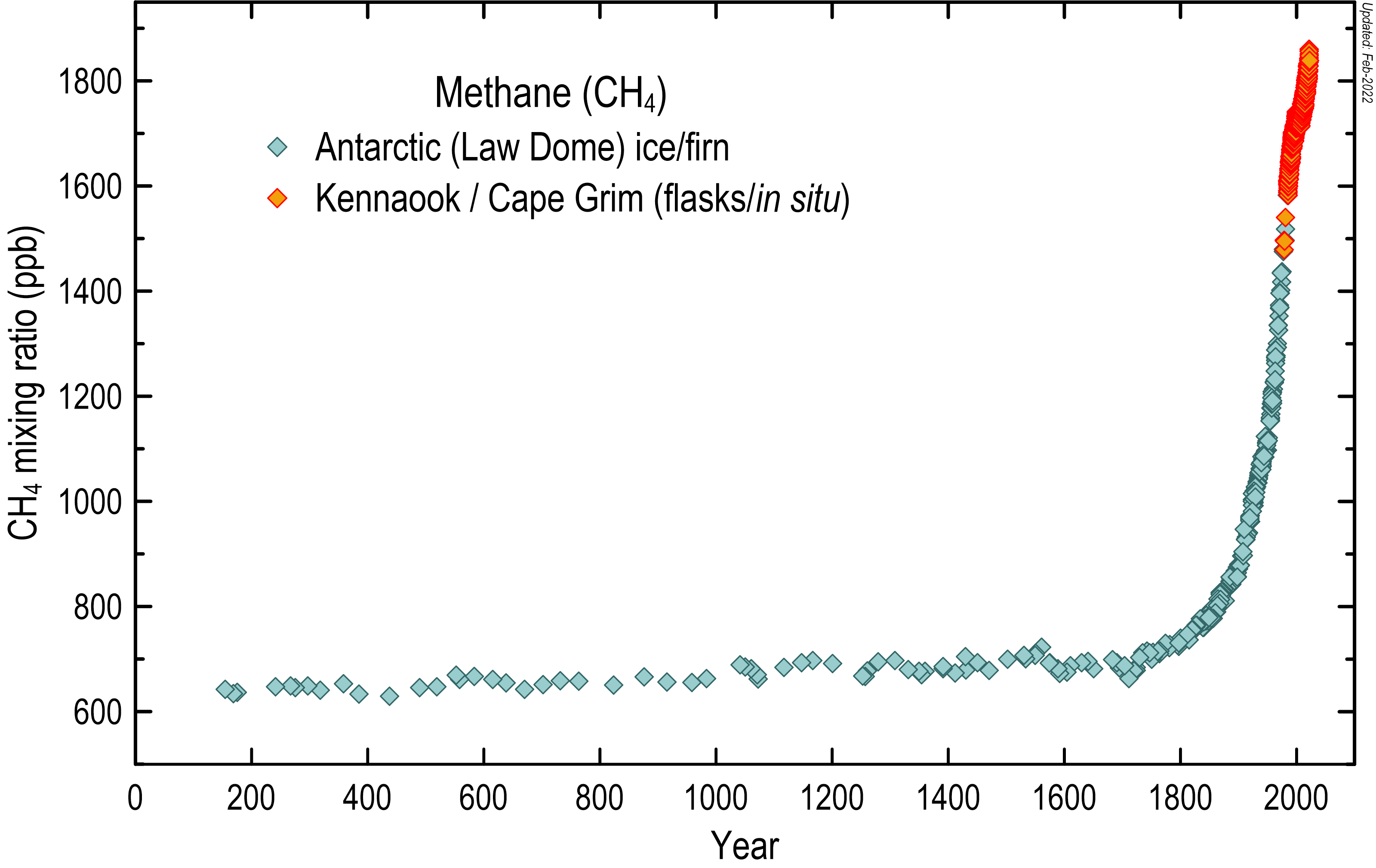Global atmospheric methane
After carbon dioxide, methane is the most important greenhouse gas contributing to human-induced climate change. Methane remains in the atmosphere for a much shorter timeframe compared to carbon dioxide; around nine years compared with the hundreds to thousands of years for carbon dioxide. However, methane has a higher global warming potential than carbon dioxide (86 times larger over 20 years). This is because methane absorbs thermal infrared radiation from the sun much more efficiently than carbon dioxide so holds more heat in our atmosphere.

As reported in the latest global methane budget, global methane emissions have increased by 20 per cent in the last 20 years.
There has been higher growth rates for methane over the past three years, from 2020-2022, with a record high in 2021.
The global average methane concentrations in the atmosphere reached approximately 1875 parts per billion at the end of 2019. This is more than two and a half times preindustrial levels.
The amount of global atmospheric methane is increasing by around 12 parts per billion each year. This rate of increase is consistent with a scenario modelled by the Intergovernmental Panel on Climate Change under which Earth will warm by between three and four degrees Celsius by 2100. To keep global warming to the Paris Agreement target of below two degrees Celsius, methane emissions need to be reduced.
Sources and sinks of methane
The budget covers 17 natural and anthropogenic (human-induced) sources and shows that methane has increased by 61 million metric tonnes per year. There are both human-derived and natural sources of methane emissions. Around 60 per cent of methane emissions were human-made, and the increase in emissions was exclusively the result of human activities.
The main sources of human-derived methane emissions include, in order of contribution:
- agriculture and waste, particularly emissions from livestock, manure, landfills, and rice farming
- the production and use of fossil fuels, mainly from the oil and gas industry, followed by coal mining
- biomass burning, from wood burning for heating, bushfires and burning biofuels.
The remaining emissions (40 per cent) come from natural sources. In order of contribution, these include:
- wetlands, mostly in tropical regions and cold parts of the planet such as Siberia and Canada
- lakes and rivers
- natural geological sources on land and oceans such as gas–oil seeps and mud volcanoes
- smaller sources such as tiny termites in the savannas of Africa and Australia.
The main sink for methane emissions comes from chemical reactions in the atmosphere that ultimately destroy it. A small amount is also absorbed by soils.
Methane is accumulating in the atmosphere because human activities are causing methane to be produced at a much faster rate than these natural processes can destroy it.
Global atmospheric methane
After carbon dioxide, methane is the most important greenhouse gas contributing to human-induced climate change. Methane remains in the atmosphere for a much shorter timeframe compared to carbon dioxide; around nine years compared with the hundreds to thousands of years for carbon dioxide. However, methane has a higher global warming potential than carbon dioxide (86 times larger over 20 years). This is because methane absorbs thermal infrared radiation from the sun much more efficiently than carbon dioxide so holds more heat in our atmosphere.
Atmospheric methane concentrations (in ppb) over the last 2000 years, based on measurements of air trapped in Antarctic ice and firn, shown in blue-grey diamonds, and the modern Cape Grim in situ record, shown in orange.
As reported in the latest global methane budget, global methane emissions have increased by 20 per cent in the last 20 years.
There has been higher growth rates for methane over the past three years, from 2020-2022, with a record high in 2021.
The global average methane concentrations in the atmosphere reached approximately 1875 parts per billion at the end of 2019. This is more than two and a half times preindustrial levels.
The amount of global atmospheric methane is increasing by around 12 parts per billion each year. This rate of increase is consistent with a scenario modelled by the Intergovernmental Panel on Climate Change under which Earth will warm by between three and four degrees Celsius by 2100. To keep global warming to the Paris Agreement target of below two degrees Celsius, methane emissions need to be reduced.
Sources and sinks of methane
The budget covers 17 natural and anthropogenic (human-induced) sources and shows that methane has increased by 61 million metric tonnes per year. There are both human-derived and natural sources of methane emissions. Around 60 per cent of methane emissions were human-made, and the increase in emissions was exclusively the result of human activities.
The main sources of human-derived methane emissions include, in order of contribution:
- agriculture and waste, particularly emissions from livestock, manure, landfills, and rice farming
- the production and use of fossil fuels, mainly from the oil and gas industry, followed by coal mining
- biomass burning, from wood burning for heating, bushfires and burning biofuels.
The remaining emissions (40 per cent) come from natural sources. In order of contribution, these include:
- wetlands, mostly in tropical regions and cold parts of the planet such as Siberia and Canada
- lakes and rivers
- natural geological sources on land and oceans such as gas–oil seeps and mud volcanoes
- smaller sources such as tiny termites in the savannas of Africa and Australia.
The main sink for methane emissions comes from chemical reactions in the atmosphere that ultimately destroy it. A small amount is also absorbed by soils.
Methane is accumulating in the atmosphere because human activities are causing methane to be produced at a much faster rate than these natural processes can destroy it.
Related research
Read more about our research to monitor, understand and ultimately reduce methane emissions.
